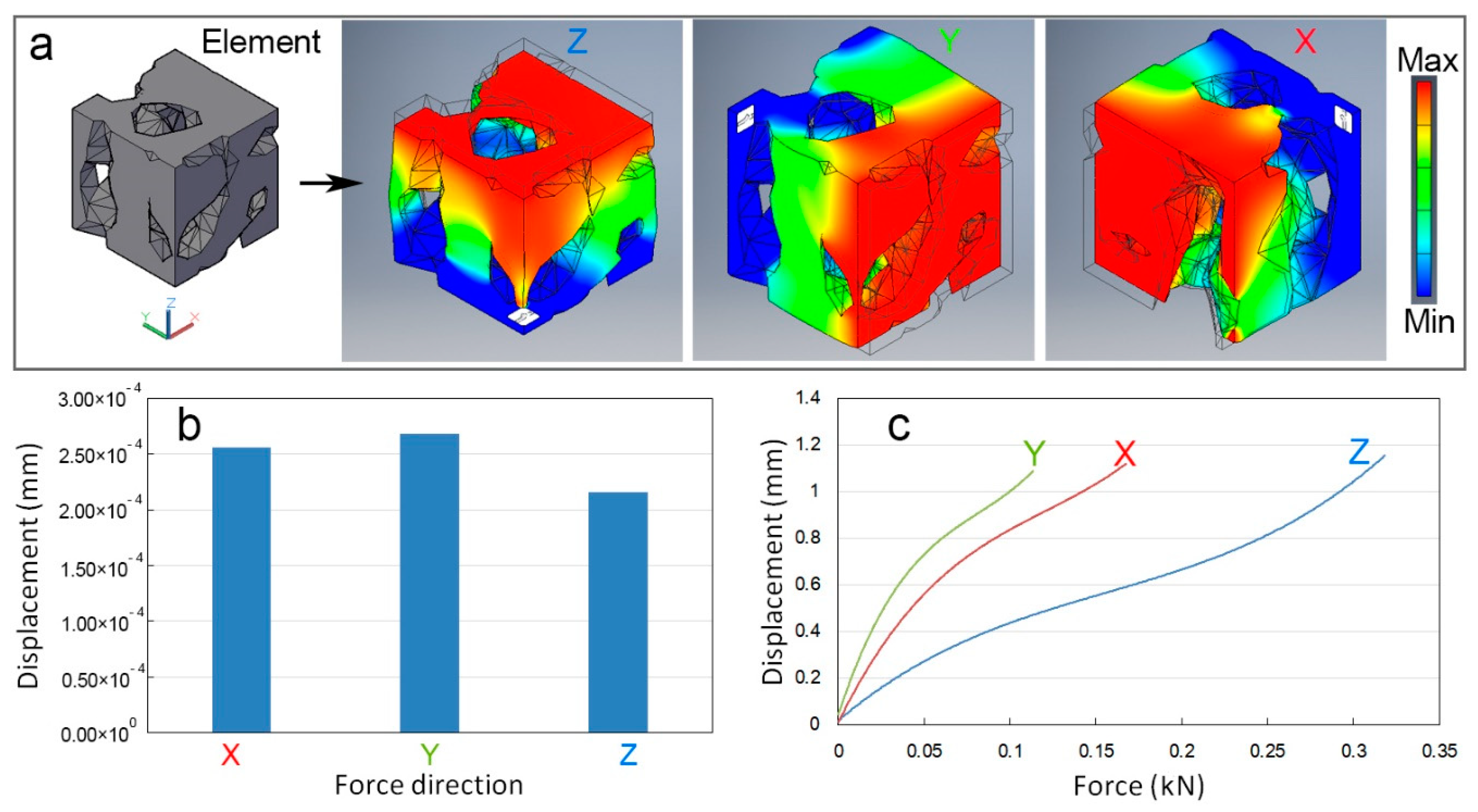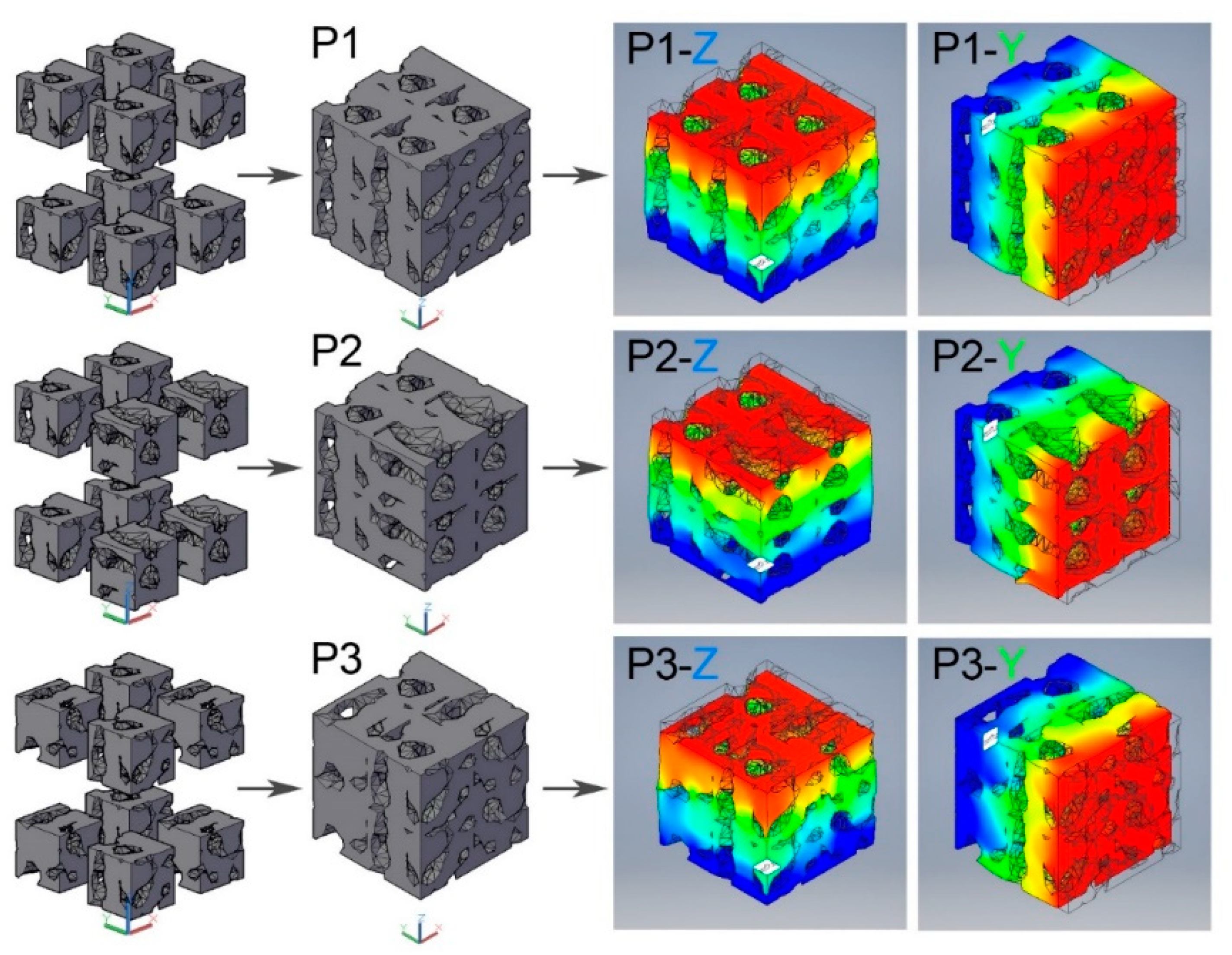A Design and Fabrication Method for Wood-Inspired Composites by Micro X-Ray Computed Tomography and 3D Printing
Abstract
:1. Introduction
2. Materials and Methods
2.1. CT Scanning and Volume Reconstruction
2.2. 3D Printing
2.3. Compression Simulations
2.4. Compression Experiments
3. Results and Discussion
3.1. Wood Volume Reconstruction and 3D Printing
3.2. Effects of 3D Volume Reconstruction Parameters on the Model
3.3. Elementary Model Compression Analysis
3.4. Composite Performance Tuning
4. Conclusions
Author Contributions
Funding
Conflicts of Interest
References
- Liu, Z.; Meyers, M.A.; Zhang, Z.; Ritchie, R.O. Functional gradients and heterogeneities in biological materials: Design principles, functions, and bioinspired applications. Prog. Mater. Sci. 2017, 88, 467–498. [Google Scholar] [CrossRef]
- Weinkamer, R.; Fratzl, P. Mechanical adaptation of biological materials—The examples of bone and wood. Mater. Sci. Eng. C 2011, 31, 1164–1173. [Google Scholar] [CrossRef]
- Li, P.; Pan, L.; Liu, D.; Tao, Y.; Shi, S.Q. A Bio-Hygromorph Fabricated with Fish Swim Bladder Hydrogel and Wood Flour-Filled Polylactic Acid Scaffold by 3D Printing. Materials 2019, 12, 2896. [Google Scholar] [CrossRef] [PubMed] [Green Version]
- Reichert, S.; Menges, A.; Correa, D. Meteorosensitive architecture: Biomimetic building skins based on materially embedded and hygroscopically enabled responsiveness. Comput. Aided Des. 2015, 60, 50–69. [Google Scholar] [CrossRef]
- Compton, B.G.; Lewis, J.A. 3D-Printing of Lightweight Cellular Composites. Adv. Mater. 2014, 26, 5930–5935. [Google Scholar] [CrossRef] [PubMed]
- Fratzl, P. Cellulose and collagen: From fibres to tissues. Curr. Opin. Colloid Interface Sci. 2003, 8, 32–39. [Google Scholar] [CrossRef]
- Gibson, L.J. Biomechanics of cellular solids. J. Biomech. 2005, 38, 377–399. [Google Scholar] [CrossRef] [PubMed]
- Wimmer, R.; Steyrer, B.; Woess, J.; Koddenberg, T.; Mundigler, N. 3D Printing and Wood. Pro Ligno 2015, 11, 144–149. [Google Scholar]
- Dixon, P.G.; Muth, J.T.; Xiao, X.; Skylar-Scott, M.A.; Lewis, J.A.; Gibson, L.J. 3D printed structures for modeling the Young’s modulus of bamboo parenchyma. Acta Biomater. 2018, 68, 90–98. [Google Scholar] [CrossRef] [PubMed] [Green Version]
- Steppe, K.; Cnudde, V.; Girard, C.; Lemeur, R.; Cnudde, J.; Jacobs, P. Use of X-ray computed microtomography for non-invasive determination of wood anatomical characteristics. J. Struct. Biol. 2004, 148, 11–21. [Google Scholar] [CrossRef]
- Forsberg, F.; Mooser, R.; Arnold, M.; Hack, E.; Wyss, P. 3D micro-scale deformations of wood in bending: Synchrotron radiation μCT data analyzed with digital volume correlation. J. Struct. Biol. 2008, 164, 255–262. [Google Scholar] [CrossRef] [PubMed]
- Mayo, S.C.; Chen, F.; Evans, R. Micron-scale 3D imaging of wood and plant microstructure using high-resolution X-ray phase-contrast microtomography. J. Struct. Biol. 2010, 171, 182–188. [Google Scholar] [CrossRef] [PubMed]
- Li, P.; Tao, Y.; Wu, Q. A three-dimensional void reconstruction method for analyzing fractal dimensions of void volume in wood-strand composites. Holzforschung 2016, 70, 377. [Google Scholar] [CrossRef]
- Tachos, N.S.; Sakellarios, A.I.; Rigas, G.; Isailovic, V.; Ni, G.; Böhnke, F.; Filipovic, N.; Bibas, T.; Fotiadis, D.I. Middle and inner ear modelling: From microCT images to 3D reconstruction and coupling of models. In 2016 38th Annual International Conference of the IEEE Engineering in Medicine and Biology Society (EMBC); IEEE: Piscataway, NJ, USA, 2016; pp. 5961–5964. [Google Scholar] [CrossRef]
- Thompson, A.; Maskery, I.; Leach, R.K. X-ray computed tomography for additive manufacturing: A review. Meas. Sci. Technol. 2016, 27, 72001. [Google Scholar] [CrossRef]
- Guessasma, S.; Tao, L.; Belhabib, S.; Zhu, J.; Zhang, W.; Nouri, H. Analysis of microstructure and mechanical performance of polymeric cellular structures designed using stereolithography. Eur. Polym. J. 2018, 98, 72–82. [Google Scholar] [CrossRef]
- Tao, Y.; Pan, L.; Liu, D.; Li, P. A case study: Mechanical modeling optimization of cellular structure fabricated using wood flour-filled polylactic acid composites with fused deposition modeling. Compos. Struct. 2019, 216, 360–365. [Google Scholar] [CrossRef]
- Otsu, N. A threshold selection method from gray-level histograms. IEEE Trans. Syst. Man Cybern. 1979, 9, 62–66. [Google Scholar] [CrossRef] [Green Version]
- Aimene, Y.E.; Nairn, J.A. Simulation of transverse wood compression using a large-deformation, hyperelastic–plastic material model. Wood Sci. Technol. 2015, 49, 21–39. [Google Scholar] [CrossRef]
- Dizon, J.R.C.; Espera, A.H.; Chen, Q.; Advincula, R.C. Mechanical characterization of 3D-printed polymers. Addit. Manuf. 2018, 20, 44–67. [Google Scholar] [CrossRef]
- Tao, Y.; Li, P.; Pan, L. Improving tensile properties of polylactic acid parts by adjusting printing parameters of open source 3d printers. Mater. Sci. Medzg. 2020, 26, 83–87. [Google Scholar] [CrossRef] [Green Version]







© 2020 by the authors. Licensee MDPI, Basel, Switzerland. This article is an open access article distributed under the terms and conditions of the Creative Commons Attribution (CC BY) license (http://creativecommons.org/licenses/by/4.0/).
Share and Cite
Tao, Y.; Li, Z.; Li, P. A Design and Fabrication Method for Wood-Inspired Composites by Micro X-Ray Computed Tomography and 3D Printing. Appl. Sci. 2020, 10, 1400. https://doi.org/10.3390/app10041400
Tao Y, Li Z, Li P. A Design and Fabrication Method for Wood-Inspired Composites by Micro X-Ray Computed Tomography and 3D Printing. Applied Sciences. 2020; 10(4):1400. https://doi.org/10.3390/app10041400
Chicago/Turabian StyleTao, Yubo, Zelong Li, and Peng Li. 2020. "A Design and Fabrication Method for Wood-Inspired Composites by Micro X-Ray Computed Tomography and 3D Printing" Applied Sciences 10, no. 4: 1400. https://doi.org/10.3390/app10041400




